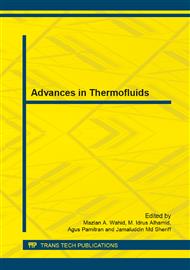[1]
H. A. Mohammed, G. Bhaskaran, N. H. Shuaib, R. Saidur: Heat transfer and fluid flow characteristics in micro channels heat exchanger using nanofluids: A review, Renewable and Sustainable Energy Reviews 15 (2011) p.1502.
DOI: 10.1016/j.rser.2010.11.031
Google Scholar
[2]
H. A. Mohammed, A. M. Abed, M. A. Wahid, The Effects of Geometrical Parameters of a Corrugated Channel with in Out-of-Phase Arrangement, International Communications Heat and Mass Transfer (2013) 40 (1), 47-57.
DOI: 10.1016/j.icheatmasstransfer.2012.10.022
Google Scholar
[3]
H. A. Mohammed, Husam A. Hasan, M. A. Wahid, Heat Transfer Enhancement of Nanofluids in A Double Pipe Heat Exchanger with Louvered Strip Inserts, International Communications in Heat and Mass Transfer (2013) 40 (1) 36 – 46.
DOI: 10.1016/j.icheatmasstransfer.2012.10.023
Google Scholar
[4]
D.B. Tuckerman, R.F.W. Peace, High-performance heat sinking for VLSI, IEEE Electron. Devices Lett. 2 (1981) 126–129.
DOI: 10.1109/edl.1981.25367
Google Scholar
[5]
X.Q. Wang, A.S. Mujumdar, A review on nanofluids. Part 1: Theoretical and Numerical investigations, Braz. J. Chem. Eng. 25 (4) (2008) 613–630.
DOI: 10.1590/s0104-66322008000400001
Google Scholar
[6]
M.N. Pantzali, A.G. Kanaris, K.D. Antoniadis, A.A. Mouza, S.V. Paras, Effect of nanofluids on the performance of a miniature plate heat exchanger with modulated surface, Int. J. Heat Fluid Flow 30 (2009) 691–699.
DOI: 10.1016/j.ijheatfluidflow.2009.02.005
Google Scholar
[7]
R. Lotfi, Y. Saboohi, A.M. Rashidi: Numerical study of forced convective heat transfer of Nanofluids: Comparison of different approaches, International Communications in Heat and Mass Transfer 37 (2010) p.74–78.
DOI: 10.1016/j.icheatmasstransfer.2009.07.013
Google Scholar
[8]
ANSYS FLUENT Workbench User's Guide and Theory Guide. Release 14. 0. ANSYS, Inc., November (2011).
Google Scholar
[9]
Manninen, M., Taivassalo, V., Kallio, S.: On the Mixture Model for Multiphase Flow, Technical Research Center of Finland, VTT Publications 288 (1996), 9–18.
Google Scholar
[10]
Yong Gang Lei, Ya-Ling He, Li-Ting Tian, Pan Chu, Wen-Quan Tao : Hydro dynamics and heat transfer characteristics of an ovel heat exchanger with delta-winglet vortex generators, Chemical Engineering Science 65 (2010) p.1551–1562.
DOI: 10.1016/j.ces.2009.10.017
Google Scholar
[11]
Y.B. Tao, Y.L. He , J. Huang, Z.G. Wu, W.Q. Tao : Numerical study of local heat transfer coefficient and fin efficiency of wavy fin-and-tube heat exchangers, International Journal of Thermal Sciences 46 (2007) p.768–778.
DOI: 10.1016/j.ijthermalsci.2006.10.004
Google Scholar
[12]
Ke-Wei Song, Ye Wang, Qiang Zhang, Liang-Bi Wang, Yan-Jun Liu: Numerical study of the fin efficiency and a modified fin efficiency formula for flat tube bank fin heat exchanger, International Journal of Heat and Mass Transfer 54 (2011).
DOI: 10.1016/j.ijheatmasstransfer.2010.12.040
Google Scholar
[13]
M.K. Rathod , K. Shah Niyati, P. Prabhakaran: Performance evaluation of flat finned tube fin heat exchanger with different fin surfaces, Applied Thermal Engineering 27 (2007) p.2131.
DOI: 10.1016/j.applthermaleng.2006.10.030
Google Scholar
[14]
V. Bianco, F. Chiacchio, O. Manca, and S. Nardini: Numerical investigation of nanofluids forced convection in circular tubes, Applied Thermal Engineering, vol. 29, no. 17-18, (2009) p.3632.
DOI: 10.1016/j.applthermaleng.2009.06.019
Google Scholar
[15]
Mohammad Nazififard, Mohammadreza Nematollahi, Khosrow Jafarpur, and Kune Y. Suh : Numerical Simulation of Water-Based Alumina Nanofluid in Subchannel Geometry, Science and Technology of Nuclear Installations Volume 2012, Article ID 928406, (2012).
DOI: 10.1155/2012/928406
Google Scholar
[16]
R.L. Hamilton, O.K. Crosser : Thermal conductivity of heterogeneous two component systems, I&EC Fundamentals 1 (3) (1962) p.187–191.
DOI: 10.1021/i160003a005
Google Scholar
[17]
S.B. Maiga, S.J. Palm, C.T. Nguyen, G. Roy, Nicolas Galanis : Heat transfer enhancement by using nanofluids in forced convection flows, International Journal of Heat and Fluid Flow 26 (4) (2005) p.530–546.
DOI: 10.1016/j.ijheatfluidflow.2005.02.004
Google Scholar
[18]
S.B. Maiga, S.J. Palm, C.T. Nguyen, G. Roy, Nicolas Galanis, Heat transfer enhancement by using nanofluids in forced convection flows, International Journal of Heat and Fluid Flow 26 (4) (2005) 530–546.
DOI: 10.1016/j.ijheatfluidflow.2005.02.004
Google Scholar
[19]
Zukauskas, A.: Heat transfer from tubes in crossflow. In: Hartnett, J.P., Irvine, J.T.F. (eds. ) Advances in Heat Transfer, vol. 8 (1972), p.93–160.
DOI: 10.1016/s0065-2717(08)70038-8
Google Scholar
[20]
Zukauskas, A., Skrinska, A., Ziugzda, J., Gnielinski, V.: Single phase convective heat transfer: Banks of plain and finned tubes. In: Hewitt, G. (ed. ) Heat Exchanger Design Handbook, ch. 2. 5. 3. Begell House, New York (1998).
DOI: 10.1615/hedhme.a.000170
Google Scholar
[21]
Jun-Bo Huang and Jiin-Yuh Jang : Numerical Investigation of Nanofluids Laminar Convective Heat Transfer through Staggered and In-Lined Tube Banks, F.L. Gaol et al. (Eds. ): Proc. of the 2011 2nd International Congress on CACS, AISC 144, (2012).
DOI: 10.1007/978-3-642-28314-7_65
Google Scholar


